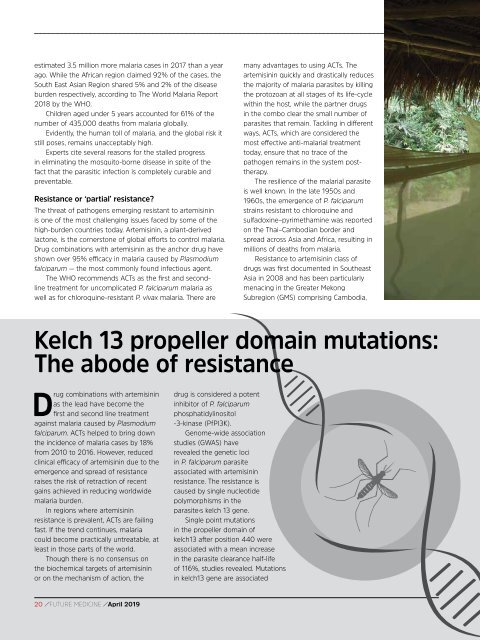You also want an ePaper? Increase the reach of your titles
YUMPU automatically turns print PDFs into web optimized ePapers that Google loves.
estimated 3.5 million more malaria cases in 2017 than a year<br />
ago. While the African region claimed 92% of the cases, the<br />
South East Asian Region shared 5% and 2% of the disease<br />
burden respectively, according to The World Malaria Report<br />
2018 by the WHO.<br />
Children aged under 5 years accounted for 61% of the<br />
number of 435,000 deaths from malaria globally.<br />
Evidently, the human toll of malaria, and the global risk it<br />
still poses, remains unacceptably high.<br />
Experts cite several reasons for the stalled progress<br />
in eliminating the mosquito-borne disease in spite of the<br />
fact that the parasitic infection is completely curable and<br />
preventable.<br />
Resistance or ‘partial’ resistance?<br />
The threat of pathogens emerging resistant to artemisinin<br />
is one of the most challenging issues faced by some of the<br />
high-burden countries today. Artemisinin, a plant-derived<br />
lactone, is the cornerstone of global efforts to control malaria.<br />
Drug combinations with artemisinin as the anchor drug have<br />
shown over 95% efficacy in malaria caused by Plasmodium<br />
falciparum — the most commonly found infectious agent.<br />
The WHO recommends ACTs as the first and secondline<br />
treatment for uncomplicated P. falciparum malaria as<br />
well as for chloroquine-resistant P. vivax malaria. There are<br />
many advantages to using ACTs. The<br />
artemisinin quickly and drastically reduces<br />
the majority of malaria parasites by killing<br />
the protozoan at all stages of its life-cycle<br />
within the host, while the partner drugs<br />
in the combo clear the small number of<br />
parasites that remain. Tackling in different<br />
ways, ACTs, which are considered the<br />
most effective anti-malarial treatment<br />
today, ensure that no trace of the<br />
pathogen remains in the system posttherapy.<br />
The resilience of the malarial parasite<br />
is well known. In the late 1950s and<br />
1960s, the emergence of P. falciparum<br />
strains resistant to chloroquine and<br />
sulfadoxine–pyrimethamine was reported<br />
on the Thai–Cambodian border and<br />
spread across Asia and Africa, resulting in<br />
millions of deaths from malaria.<br />
Resistance to artemisinin class of<br />
drugs was first documented in Southeast<br />
Asia in 2008 and has been particularly<br />
menacing in the Greater Mekong<br />
Subregion (GMS) comprising Cambodia,<br />
Kelch 13 propeller domain mutations:<br />
The abode of resistance<br />
Drug combinations with artemisinin<br />
as the lead have become the<br />
first and second line treatment<br />
against malaria caused by Plasmodium<br />
falciparum. ACTs helped to bring down<br />
the incidence of malaria cases by 18%<br />
from 2010 to 2016. However, reduced<br />
clinical efficacy of artemisinin due to the<br />
emergence and spread of resistance<br />
raises the risk of retraction of recent<br />
gains achieved in reducing worldwide<br />
malaria burden.<br />
In regions where artemisinin<br />
resistance is prevalent, ACTs are failing<br />
fast. If the trend continues, malaria<br />
could become practically untreatable, at<br />
least in those parts of the world.<br />
Though there is no consensus on<br />
the biochemical targets of artemisinin<br />
or on the mechanism of action, the<br />
drug is considered a potent<br />
inhibitor of P. falciparum<br />
phosphatidylinositol<br />
-3-kinase (PfPI3K).<br />
Genome-wide association<br />
studies (GWAS) have<br />
revealed the genetic loci<br />
in P. falciparum parasite<br />
associated with artemisinin<br />
resistance. The resistance is<br />
caused by single nucleotide<br />
polymorphisms in the<br />
parasite›s kelch 13 gene.<br />
Single point mutations<br />
in the propeller domain of<br />
kelch13 after position 440 were<br />
associated with a mean increase<br />
in the parasite clearance half-life<br />
of 116%, studies revealed. Mutations<br />
in kelch13 gene are associated<br />
20 / FUTURE MEDICINE / <strong>April</strong> <strong>2019</strong>


















